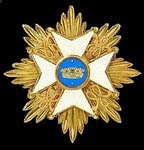Chefs: From 16th August 1752 Major General Leopold Friedrich Ludwig von Wietersheim, who was transferred to the Saxon Rochow Regiment, which was absorbed into Prussian service involuntarily in 1756; from 20th October 1756 Colonel Caspar Friedrich von Rohr, who died 12th December 1757 of wounds received at Leuthen 5th December; from 5th January 1758 Major General Christoph Heinrich von Grabow to 1764
First raised August 1743; its core was a regiment taken over from the Duke of Holstein-Gottorp. The officers were mostly sent to the garrison regiments and replaced by Prussian officers.
The regiment was with the King's army in the Pirna Campaign of 1756, then occupied Dresden until October 16th 1757. For the next few years the regiment was with the Saxon Corps. In 1759 the Corps advanced into Franconia to attempt to weaken the Imperial Army before the campaigning season began. On July 30th the regiment went with the King's Army and fought at Kunersdorf on August 12th. Fighting with the main army attack and under heavy grapeshot fire from the big battery on the Grosser Spitzberg, the regiment lost 600 men (Christopher Duffy, Army of Frederick the Great, 1st Edition, shows about 45% casualties). Only two officers survived unscathed. After the battle it joined Finck's Corps which reached Torgau in September and won the battle of Korbitz on September 21st and also the fight at Pretzsch on October 29th. Sent to cut the enemy communications, the Finck Corps marched to the plateau of Maxen through frost and snow where it was completely isolated. The Corps was forced to surrender on November 21st after losing half its number to a concerted attack by twice its numbers. The remnants of the IR47 battalion were amongst the prisoners.
In 1760 IR47's remaining battalion was in Stutterheim's Corps opposing the Swedes and protecting Berlin in October. At the end of October it joined the King but was not at Torgau.
In 7161 it was part of the defence of Kolberg under Württemberg; on November 14th it was part of the breakout to the west, fought at Spie and then withdrew to Stettin. An attempt to surround the Swedes in December failed.
In 1762 both battalions were with the army in Saxony and led the attack over the Mulde on May 12th. The regiment was not at Freiberg in 1762.
Christopher Duffy Army of Frederick the Great says of the regiment: "Taken over from the Holstein service in 1743. Heavy losses at Kunersdorf and the survivors captured at Maxen." Of the grenadier battalion (with Garrison Regiment No.7) he says: "In heavy fighting at Kolin and Domstadtl. Highly esteemed by Frederick."
And this was the uniform in 1756:
To complete all the Prussian infantry flags 1740-1763 I now have only IRs 15, 48 and 49 to do!























